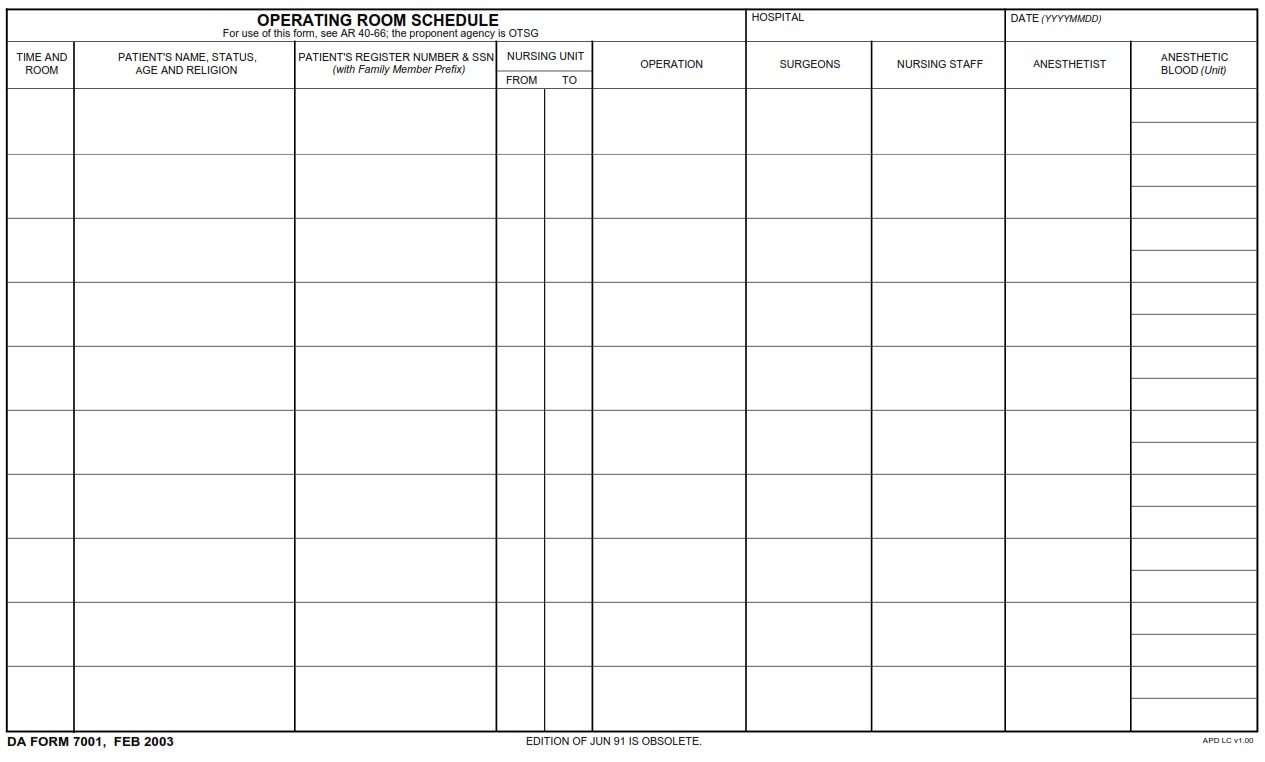Table of Contents
FREE-ONLINE-FORMS.COM – DA Form 7001 – Operating Room Schedule – In the bustling world of healthcare, where precision and timing can mean the difference between life and death, a seemingly mundane form emerges as the unsung hero behind the scenes of surgical procedures – the DA Form 7001. This unassuming document holds within its structured layout the key to orchestrating a harmonious symphony of surgeries in the operating room. Imagine a meticulously designed schedule that not only dictates when each procedure will take place but also juggles the complexities of surgical teams, equipment availability, patient readiness, and unforeseen emergencies with seamless finesse. The DA Form 7001 is more than just a piece of paper; it is a dynamic blueprint that navigates through the intricate dance of surgery scheduling with precision and efficiency. Join us as we delve into the world of this often-overlooked yet indispensable tool in modern healthcare operations.
Download DA Form 7001 – Operating Room Schedule
| Form Number | DA Form 7001 |
| Form Title | Operating Room Schedule |
| Edition Date | 2/1/2003 |
| File Size | 42 KB |
What is a DA Form 7001?
The DA Form 7001, also known as the Operating Room Schedule, serves a vital role in military healthcare settings. This form is used to record and organize surgical procedures, ensuring efficient coordination of resources and staff in operating rooms. It contains detailed information about each surgery, including patient name, procedure type, surgeon’s name, scheduled time, and necessary equipment.
By using the DA Form 7001, medical personnel can effectively plan and manage the daily schedule of surgeries to minimize delays and maximize operational efficiency. This form helps to streamline communication between various departments involved in surgical care, facilitating seamless teamwork and ensuring timely delivery of critical healthcare services. Overall, the meticulous documentation provided by the DA Form 7001 plays a crucial role in promoting patient safety and optimizing healthcare delivery within military medical facilities.
Where Can I Find a DA Form 7001?
If you’re searching for the DA Form 7001, which is an essential document used to manage operating room schedules in military medical facilities, there are a few key places where you can find it. The most reliable source for this form is typically the official Department of Defense website or the Army Publishing Directorate’s online portal. These platforms offer a wide range of military forms and publications for easy access and download.
Additionally, you may also be able to obtain the DA Form 7001 through your unit’s administrative office or medical department. It’s important to check with your organization’s designated personnel or point of contact for accurate and up-to-date information on acquiring this document. Having quick and convenient access to the DA Form 7001 is crucial for ensuring smooth operations and efficient scheduling in healthcare settings within the military environment.
DA Form 7001 – Operating Room Schedule
Picture this: a bustling operating room schedule, filled with life-saving procedures and critical surgeries. The DA Form 7001 serves as the backbone of this meticulously planned and executed schedule, detailing every aspect from patient information to surgical team assignments. It ensures that each operation runs seamlessly, minimizing errors and maximizing efficiency in an environment where every second counts.
In the high-pressure world of the operating room, precision is key. The DA Form 7001 not only helps keep track of appointments and procedures but also plays a crucial role in maintaining patient safety. By providing a comprehensive overview of the day’s activities, this form allows surgical teams to prepare adequately, anticipate challenges, and ultimately deliver top-notch care to those in need.
Beyond its organizational function, the DA Form 7001 embodies accountability and compliance within the healthcare system. By documenting every step of the surgical process, it promotes transparency and accuracy in medical record-keeping. This form exemplifies how attention to detail at every stage can lead to successful outcomes for both patients and healthcare professionals alike.
